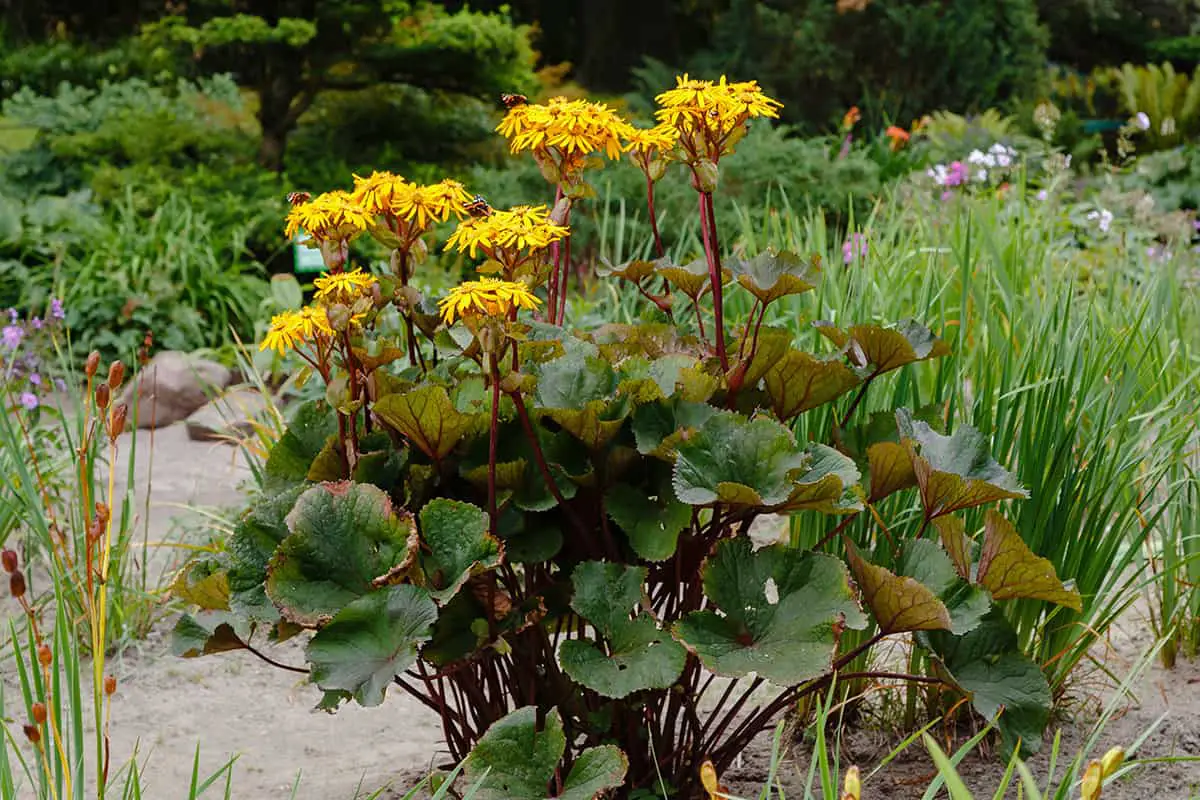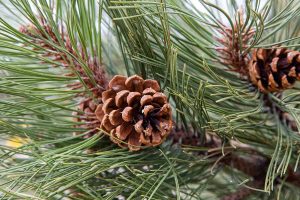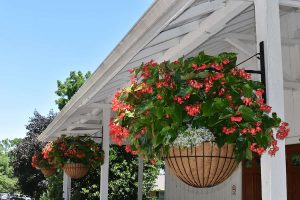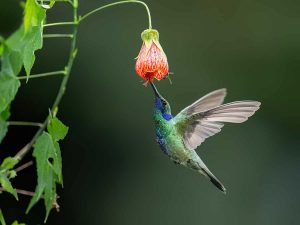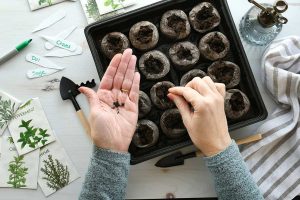Shade plants are often overlooked when designing a garden, however, they are hugely advantageous to the overall look of outdoor space, especially if there is a high degree of shade cover in the garden.
Tall perennials in particular work well under tall trees, producing height and an architectural look, along with life and color beneath the canopy of a tree.
Table of Contents
Bear’s Breeches
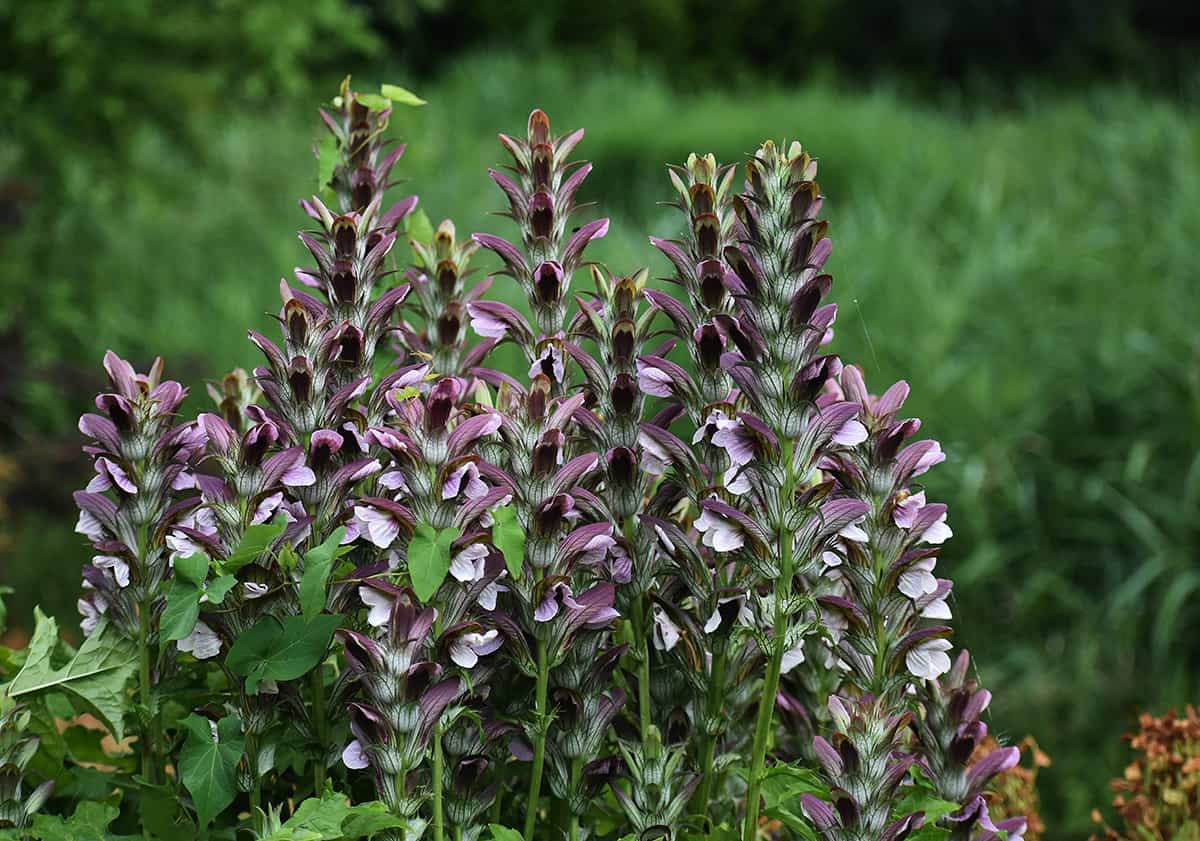
- Botanical name: Acanthus mollis
- Common names: Bear’s Foot Plant, Sea Holly, Oyster Plant, Gator Plant
- Plant family: Acanthaceae
- USDA hardiness zone: 6 – 10
- Mature height: Up to 4 feet
- Mature spread: Up to 3 feet
Bear’s Breeches is an impressive perennial plant that produces enormous, distinctive foliage in a deep emerald shade of green, and heavy lobing. The flowers are held on tall spikes that tower over the foliage through late spring and summer, typically remaining in bloom for 3 to 4 weeks at a time.
These take the shape of small white blossoms which have purple bracts as colorful hoods. They are attractive to a wide range of pollinators and are followed by seed pods that explode open when ripe. This typically happens in the evening, and you can hear the popping sound the seed pods make if you are nearby.
These are easy-care plants that don’t cause any issues in the garden unless you wish to transplant them. Their roots grow vigorously, and if you leave behind any roots when moving the plant, a new plant will grow in its place. They can be very hard to get rid of because of this, and in some areas of the US are actually considered an invasive species.
Care
Light
Bear’s Breeches can thrive in a range of lighting conditions, from full sun to shade. Dappled shade usually works best, especially in warmer climates, because the plant won’t be subjected to high levels of heat while in dappled shade, but it will receive enough sun to help it thrive. Plant it beneath the open canopy of a taller tree, allowing it shade and sun through different times of the day.
Soil
This plant can thrive in most types of soil, including heavy clay soils, sandy soils, poor soils, and loamy soils. In poor soils it will benefit from frequent applications of fertilizer, though in average or rich soils fertilizer will not be necessary. Ensure the soil is able to drain well so that it doesn’t get waterlogged.
Water
Bear’s breeches are resistant to drought once they are established, however, they will perform best with frequent watering.
During dry summers, supplement the plant with watering every few days. In dry soil, the leaves of the plant can start to wilt, though it will usually recover when it can access moisture again.
Temperature
These are hardy plants that fare best in USDA hardiness zones 6 through to 10. As perennial plants, their foliage will die back to the ground in cooler climates, and emerge again the following spring. For young Bear’s Breeches plants, it is best to mulch over the soil in winter to help insulate the roots against dropping temperatures. Once the plant is established this will no longer be necessary.
Elk Clover
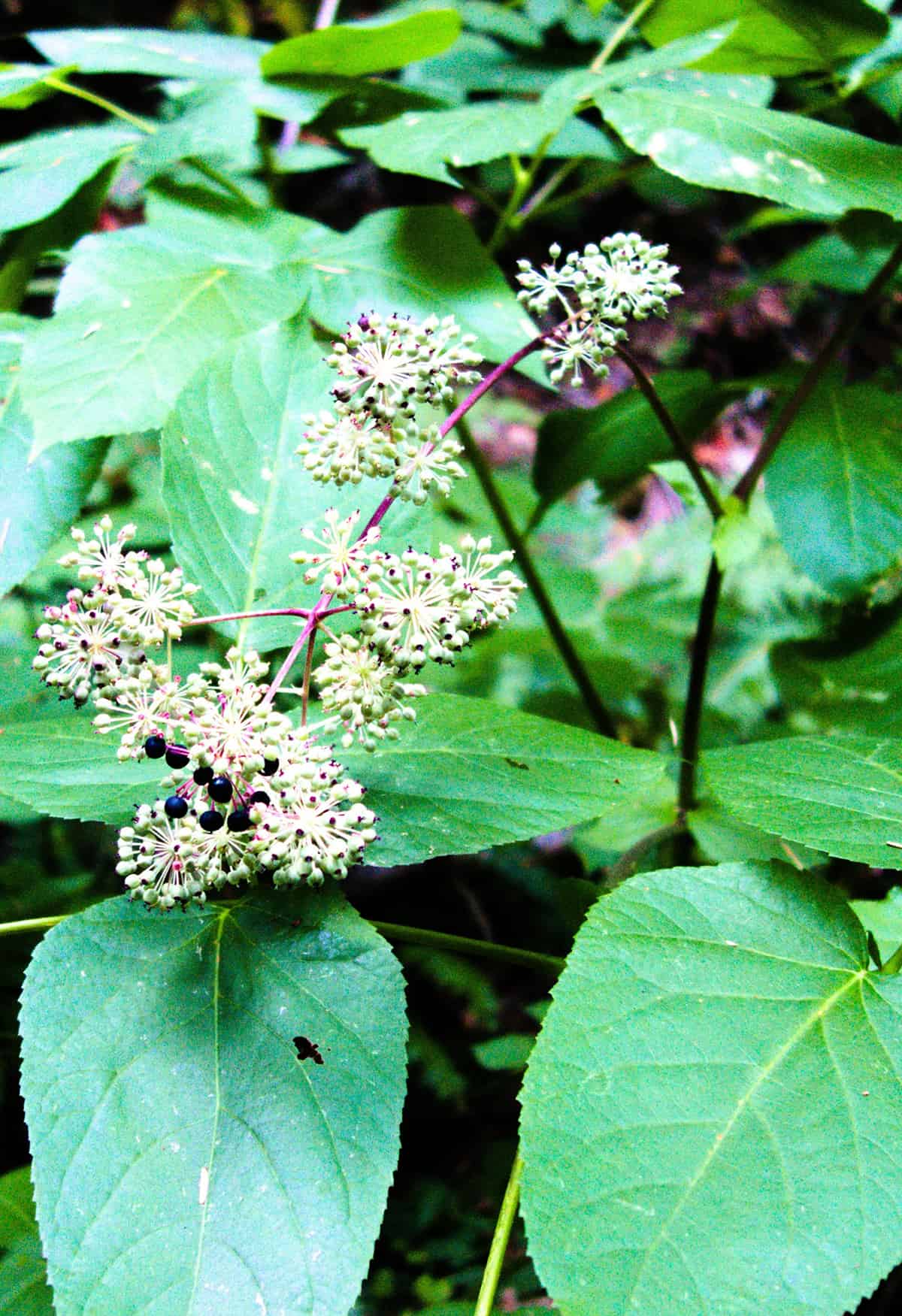
- Botanical name: Aralia californica
- Common names: California Aralia
- Plant family: Araliaceae
- USDA hardiness zone: 7 – 9
- Mature height: 6 to 10 feet
- Mature spread: 6 to 10 feet
Elk Clover is not technically a type of clover, and it actually belongs to the ginseng family. This plant is a deciduous perennial which produces long stems of pinnate leaves that create a canopy of dappled shade. Each leaf stem can span 6 feet in length and 3 feet in width, arching gently so that the entire plant forms an umbrella shape.
The leaves are green through summer, warming up to yellow in fall. This is a deciduous perennial, so the leaves will drop to the ground by winter, and will emerge again the following spring.
The flowers of the Elk Clover arrive in clusters at the end of stems which protrude out from the foliage. Each cluster can measure up to 18 inches across, with green-white flowers followed by deep purple berries. This plant is native to California and some of southern Oregon. It thrives in moist woodlands, beneath the shade of taller native trees.
Care
Light
Elk Clover is found in the wild growing beneath the shade of trees such as Douglas Fir, Pine, and Redwood. When cultivated in the home garden, similar conditions should be provided to allow the plant to thrive. Position it in the shade of taller trees or shrubs, or the shade of a building. Both partial shade and full shade work well.
Soil
Well-draining soils are essential for Elk Clover because they require a lot of moisture, yet are susceptible to root rot. A soil that drains well will ensure excess moisture is not held next to the roots.
As long as the soil is well-draining, the Elk Clover is not fussy. It can be grown in clay, sand, poor, or loamy soils, though does prefer soils that have a neutral or slightly acidic pH.
Water
Elk Clover grows best in soils that are consistently moist, so you should aim to provide enough supplementary water during dry periods to prevent the soil from drying out. This plant is not tolerant of drought.
Temperature
This plant thrives in mild climates and is hardy down to USDA zone 7.
Leopard Plant

- Botanical name: Ligularia dentata
- Common names: Leopard Plant, Summer Ragwort, Big Leaf Ligularia
- Plant family: Asteraceae
- USDA hardiness zone: 3 – 8
- Mature height: Up to 4 feet
- Mature spread: Up to 3 feet
The Leopard Plant is a perennial which grows in clumps and is native to Japan and China. It produces leathery foliage which is green on the surface and bronze beneath, and the leaves are considered to be as interesting as the flowers it sends out in the middle of summer.
The flowers arrive on tall stems which stand above the foliage in clusters. Each deep orange-yellow flower will typically measure between 2 and 4 inches across and have the look of a large daisy. The plant will remain in bloom through to fall, providing many weeks of colorful interest.
Care
Light
This plant is quite robust, but it is sensitive to high levels of sun. It performs best in partial shade but will also fare well in full shade, making it an excellent choice for planting beneath taller shrubs and trees.
While it can tolerate some sun, the leaves can be prone to wilting in excessive sunlight, especially in hot climates. In cooler climates, more hours of sun will be tolerated.
Soil
The Leopard Plant relies on consistent moisture in the soil to survive, so the soil should not be too well-draining, though moderately well-draining soil is fine. This perennial plant thrives in soils that are fertile and rich in organic content. Deep soils are also needed for the vigorous, far-reaching roots of the Leopard Plant.
Water
The roots of the Leopard Plant need constant access to moisture, so you should never allow the soil it is grown in to dry out. This will mean daily supplemental watering during hot, dry summers. While the plant prefers moist soils, it can also thrive in wet soils. It grows well alongside riverbanks, woodland streams, and ponds.
Temperature
This is a hardy plant that can be grown through USDA hardiness zones 3 to 8. It is sensitive to high levels of heat and should not be grown in hot climates.
False Goat’s Beard
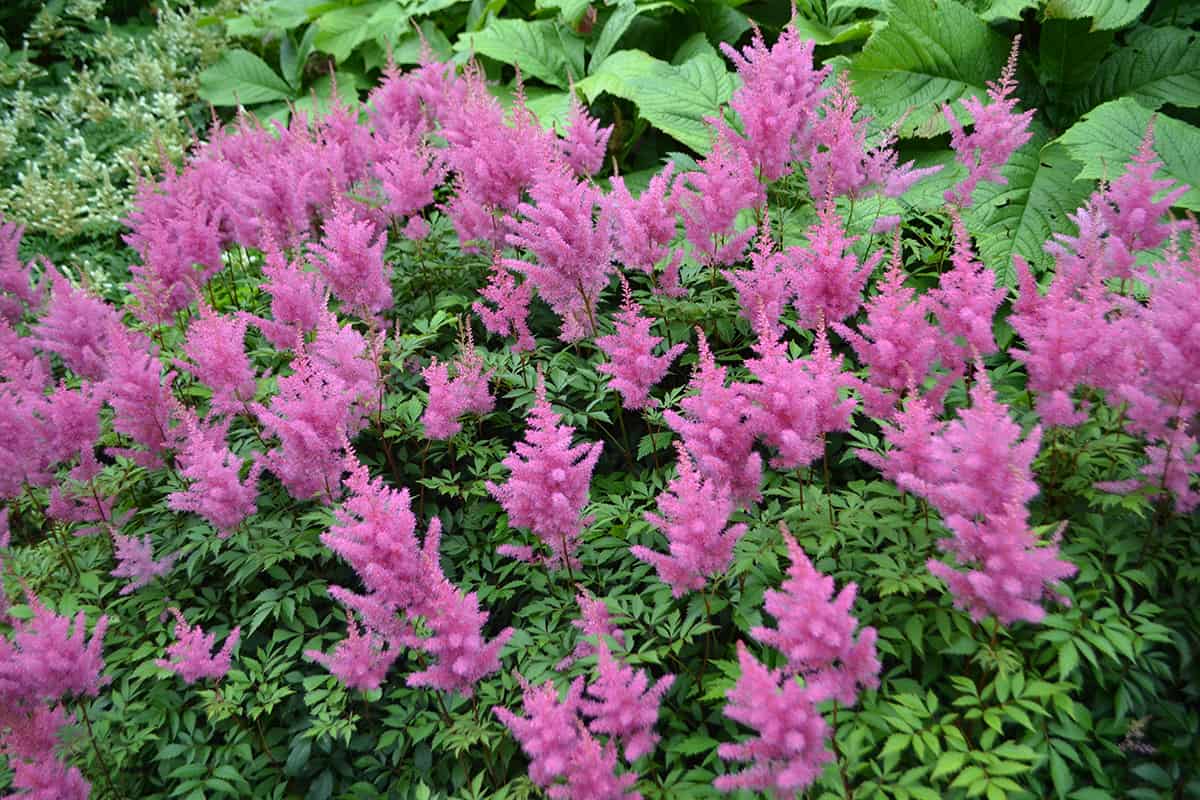
- Botanical name: Astilbe sp.
- Common names: False Goat’s Beard, False Spirea
- Plant family: Saxifragaceae
- USDA hardiness zone: 3 – 9
- Mature height: 2 to 5 feet
- Mature spread: 1 to 4 feet
False Goat’s Beard is the common name for Astilbe, which is a genus of perennial plants native to both Asia and North America, though many of the varieties you will see in gardens today are hybrids. These plants produce attractive foliage which resembles fern fronds, and these are green through spring and summer, fading to a bronze hue in fall and winter in milder climates.
The flowers are produced on tall, erect stems, which rise above the leaves below. The blooms arrive in numerous fluffy plumes which have a soft and delicate look.
They come in a range of shades of pink purple and white, from gentle cotton candy pink and pale lavender, through to vibrant hot pink and deep purple. These shade-loving perennials bloom for many weeks in ideal conditions, from spring right through to the end of summer.
Care
Light
False Goat’s Beard thrives in partial shade and full shade. It will bloom in abundance even in deep shade, making it a great choice for adding color and height beneath the canopy of tall, dense trees. It can tolerate low levels of sun in cooler climates, but should be kept out of direct sunlight in warmer regions.
Soil
The soil of this plant should be loamy and well-draining. It should also be rich in organic content.
Water
The False Goat’s Beard plant thrives in moist and wet soils, growing best alongside woodland riverbanks, streams, lakes, and ponds. The soil of this plant should not be allowed to dry out, so supplementary water will be very important in dry climates.
If the plant is positioned in a sunny spot, then consistently moist soil will be a priority. Add a layer of mulch to the soil to help reduce moisture evaporation and maintain moist conditions.
Temperature
This is a hardy plant that performs best in cold to moderate climates. It is sensitive to high levels of heat and therefore isn’t suitable for growing in USDA hardiness zones 10 or above.
Foxgloves
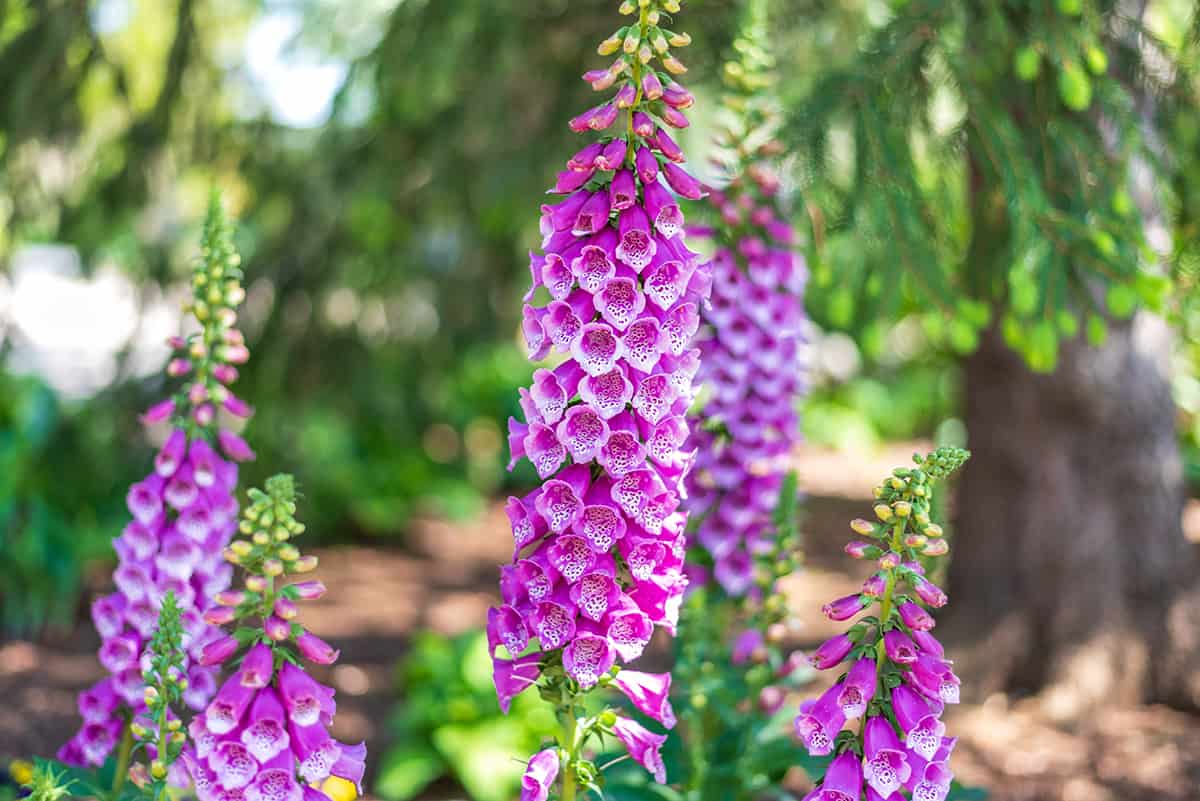
- Botanical name: Digitalis sp
- Common names: Foxgloves
- Plant family: Plantaginaceae
- USDA hardiness zone: 3 – 9
- Mature height: Up to 6 feet
- Mature spread: 1 to 2 feet
Foxgloves are native to Asia, Africa, and Europe. They can be perennial or biennial shrubs and plants, which add architectural height to a garden with their tall spikes of flowers. The flowers are funnel-shaped and come in a wide range of colors, blooming from spring through to midsummer.
The flowers are known for being hugely popular among pollinators, most notably long-tongued bees who sit inside the blooms to collect nectar and pollen. The Foxgloves’ natural habitat is woodland, where they grow beneath the shade of taller trees. This makes them ideal for growing in a shady garden.
Care
Light
Foxgloves will thrive in partial shade or full shade. Plant them in a darker corner of your garden, or beneath the canopy of a tree. They can survive in sunnier spots in cooler climates but are sensitive to hot sun, so aim to have them shaded during the afternoons if possible. Too much sunlight can scorch the leaves of this plant.
Soil
Foxglove plants are capable of thriving in a range of different soil types, including clay soils, though they have a preference for rich, fertile soils. If you have poor soil in your garden, amend it by digging in some organic compost, and increase the level of nutrient availability in the soil by using fertilizer through spring and summer. Well-draining soils are best for Foxgloves because although they enjoy moist conditions, they can suffer when the soil is waterlogged.
Water
Foxgloves grow natively in moist soils, for example along the banks of woodland streams and rivers. These conditions should be replicated in gardens for the plants’ best performance. This means watering the plant frequently during dry spells when no rain is predicted, in order to prevent the soil from drying out. Foxgloves cannot tolerate dry soil.
Temperature
Foxgloves can be grown in USDA hardiness zones 3 to 9. After the first frost, they will die back to the ground but re-emerge the following spring. Biennial Foxgloves will do this for only 1 or 2 years, while perennial Foxgloves will continue to reappear for many years.
